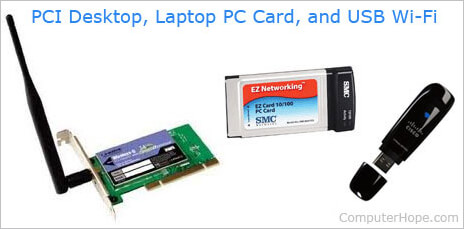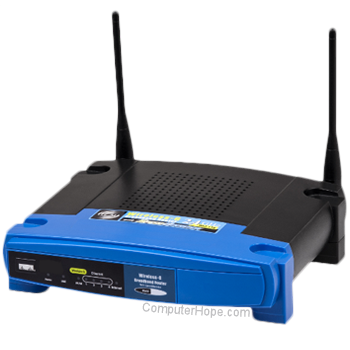Wi-Fi

Short for wireless fidelity, Wi-Fi is a wireless network that utilizes one of the IEEE 802.11 wireless standards to achieve a wireless connection to a network. A home wireless network uses a wireless access point or router to broadcast a signal using WAP (Wireless Application Protocol) or WEP (Wired Equivalent Privacy) encryption to send and receive signals from wireless devices.
Wi-Fi was featured as a top term of 2000.
Wireless adapters
If the desktop computer or laptop does not have wireless built-in, an adapter is required to connect to the wireless network. Below are examples of the different Wi-Fi adapters that can be used with a computer to connect to a wireless network.

In the picture above, the left image is a Linksys desktop Wi-Fi card that connects to a PCI (peripheral component interconnect) slot on the motherboard. The middle image is the SMC wireless PC Card used with older laptops that do not have a wireless option. The right image is a Cisco USB (universal serial bus) Wi-Fi adapter that can be used on any computer with a USB port to connect to a Wireless network.
Where do I download drivers for my Wi-Fi?
The macOS, Linux, and Windows drivers for Wi-Fi devices are found on the website of the manufacturer of your computer or the network adapter manufacturer. If you're using a laptop, we suggest getting the latest drivers from the computer manufacturer.
Some laptop manufacturers may include the Wi-Fi drivers in the chipset driver download and not as a separate Wi-Fi adapter driver.
If Wi-Fi is not working on your device, it may not be possible to download the drivers for your device without working Internet. Download the drivers on another computer, copy the install files to a USB thumb drive, and install them on your computer from the thumb drive.
Why is Wi-Fi used?
Without Wi-Fi, every network device would need to connect to the network with a network cable (e.g., Cat 5). Having a cable for every computer and network device makes installation and deployment difficult, especially for a home without the proper wiring. It also makes mobility (e.g., moving around the home or office) impossible. With Wi-Fi, any compatible device with the proper reception and access rights can connect to the network without dragging a cable to that device.
Examples of devices that use Wi-Fi
Today, most IoT (Internet of Things) devices connect to the Internet using Wi-Fi. Below is a short list of Wi-Fi devices you may find in a home or office. Also, see our wireless definition for a list of other wireless devices that use a different spectrum to communicate wirelessly.
- Chromecast, Roku, and other streaming devices.
- Computers.
- Consoles (e.g., PlayStation, Wii, and Xbox).
- Digital photo frames.
- DVD (digital versatile disc) and Blu-ray players.
- DVR (digital video recorder) and set-top box.
- eBook readers.
- Home automation devices (e.g., Nest Thermostat).
- Printer.
- Scales.
- Smart TV.
- Smartphone.
- Speakers and stereo systems.
- Security cameras.
- Tablet.
How can I get Wi-Fi in my home or office?
To get Wi-Fi in your home or office, you must have a wireless router (shown below). Your ISP (Internet service provider) may provide this router, or you may need to purchase the router from a local retail store or online and connect it to your existing network. Once the network is connected to your Internet, you can use any device with Wi-Fi capabilities to connect to the Internet.

History of Wi-Fi
Wi-Fi consists of multiple technologies that use many different patents held by various companies, so there is no one inventor or developer. In 1971, a UHF wireless packet network was used in Hawaii, called ALOHAnet, to connect the islands. While not the Wi-Fi we know today, it helped lay the foundation for wireless networking.
The actual precursor to 802.11 and Wi-Fi was developed by AT&T Corporation and NCR Corporation. Called WaveLAN, it was designed for use with cash register systems for wireless communication.
In 1997, the first version of 802.11 was developed and released for use, providing 2 Megabit per second (Mbit/s) speeds. It would later be updated to 802.11b in 1999, increasing the speed to 11 Mbit/s.
The term "Wi-Fi" was coined by the Interbrand Corporation at the request of the Wi-Fi Alliance. It is not known exactly when 802.11b became known as Wi-Fi, but the term was used in August 1999, if not earlier.
What is a public Wi-Fi?
A public Wi-Fi or public hotspot is an open Wi-Fi that requires no username or password to access the network. These networks can get you on the Internet but should not be used when entering sensitive information. For example, you should not log into your bank or enter credit card information; anything entered on a public Wi-Fi could be captured by the host or anyone nearby.
If you need to enter sensitive information or log into an account, use your smartphone as a hotspot and connect to the Internet using your smartphone. For help, see: How to turn your smartphone into a Wi-Fi hotspot.
Is Wi-Fi short for wireless fidelity?
No. Wi-Fi is a brand name and is not short for anything, including "wireless fidelity," which could be considered a backronym for Wi-Fi.
3G, 4G, Access point, Computer abbreviations, Computer portmanteaus, Cordless, Hotspot, IEEE 802.11, Internet, Network, Network terms, Phone terms, Router, Signal, WAN, Wi-Fi calling, Wi-Fi extender, Wireless, WLAN
